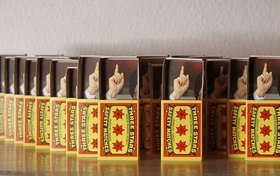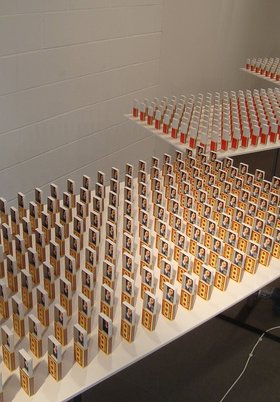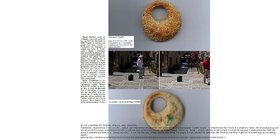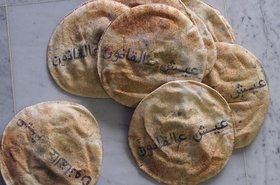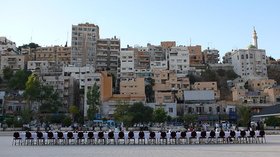Interviews
Human Mechanics
Pascal Hachem in conversation with Nour K Sacranie
Pascal Hachem lives and works in Beirut, where he is Creative Director of Pslab and Design Instructor at the American University of Beirut. In this interview with Nour Sacranie, Hachem talks about the political, the mechanical and the temporal in his artistic practice within the context of working under the ever-unpredictable conditions in Beirut. Sacranie and Hachem revisit a 2010 exhibition Bring the Boys Back Home, shown at Selma Feriani Gallery, London, exploring the themes and ideas explored in works presented, just as Hachem returns to the gallery once more for his latest show, opening January 2013, titled BELIEFS IN SELF-DECEPTION.
Nour K Sacranie: I'd like to start by talking about your 2010 exhibition at Selma Feriani Gallery in London, Bring the Boys Back Home. Could you talk about your thinking behind the show and what the impetus was for creating this highly politicised body of work?
Pascal Hachem: My work is always related to the moment of 'now'. I have to live each moment where each day is full of surprises. For me, this might influence my work drastically, causing me to drift or change ideas. In producing Bring the Boys Back Home, I was existing specifically in that moment, when the idea of power was so strong in my daily life and I had on my mind how political leaders could appear so suddenly, exist within their power and start playing these political games knowing that later on they could easily disappear and a new leader will step in to take their place…
NKS: You never show the face of the leaders you portray in your work. It is more about the leaders' gesticulation: a gesture rather than a face. Why is that?
PH: The reason for this is reflective of two aspects. First of all, I wanted to make the point of view more universal: I could easily have shown the face. But it was very important for me to show the aggression behind this gesture without showing the face because you can easily retrace the whole face without showing it. Two, this is an image of a politician who is very known within my given context and my issue was not to criticise just one politician. For me, it was about all politicians and leaders, and how they exist with their powers. For example, & Co (2010) was a selection of a few politicians; some who do not exist anymore, some who have disappeared and others who have disappeared and I don't know what happened to them. But the main piece in Bring the Boys Back Home was Look Me In The Eye (2010), which explores the fact that even if you have a repetition of the same finger by the same politician all over these platforms. But of course, you can still stumble by accident on another politician by association and make the public aware of that in a very subtle way.
NKS: The works in that 2010 exhibition are quite pre-emptive of what was to come over the two years that followed, particularly Destiny and Smatching (2010), a mechanised device with the repeated image of a politician and a matchbox being smashed against the wall. To what extent would you agree with the fact that cultural practices can influence behaviour, opinion and the political ideas of people who are looking at works like this?
PH: We live in a world where an incident in real life or fiction can both occur. In whatever I do, I play with these elements, taking more from reality. The idea of representing power and parade through these rotating platforms in Look Me In The Eye, which occupied the gallery space made the public aware of the fact that while moving through the space, the work is conditioning them to reflect on the reality that I am living in my everyday life and how I assume each one of us is experiencing it.
NKS: Let's go back to the work Destiny and Smatching (2010). Much of your work has an element of mechanisation and I wondered if, apart from the design element and your background in design, there is more to be said about these pieces as apparatuses. Thinking about Giorgio Agamben's definition of the apparatus as being anything with the possibility to capture, orient, determine, intercept and control the gestures and behaviours of living beings,[1] does this notion resonate with your thinking when you were creating these objects?
PH: Maybe it is more simple: on a level where my pieces are sometimes influenced by real life and move within the contexts and spaces that eventually disappear and fade, as we do. There is something perhaps contradictory in my way of thinking because I look at each project as something new, taking place in a moment that is constantly changing. The movement will start on the first day the show opens and ends when it closes. The time for which these machines I create are, let's say, 'living', ends there.
NKS: The work doesn't have a life beyond the show?
PH: It is not important for me to keep the objects moving. If you go through my work you will see that some things are the opposite: they are frozen and motionless. If we go back to the exhibition Bring the Boys Back Home, besides the parade and the presentation of power in the concept, the whole installation was designed to condition the publicand certainly, during the opening day, the tables kept moving. If you have a bunch of people talking to each other over these moving tables they had to keep on moving, pushing and separating themselves. This situation might condition their lives in that specific movement.
NKS: The interesting thing about these continuously moving objects is that a lot of these pieces see repetition of the same movement over and over again: they create their own continuum and some of them lead to their own destruction. With Smatching, the constant smashing against the wall leads to its destruction. What is interesting here is the interaction between the audience and the piece itself, which creates a unique subjective experience every time. This brings me to some of your earlier works, which have a more performative element. I read about your ideas on Speakers' Corner, or a type of public sphere where opinions and emotions can be expressed, and that you think that such a space is an illusion. So how do you create a space where opinions can be made through your interactive work? I am thinking specifically about Kaak Kaak (2004),which is a time and site-specific work commenting on a particular event.
PH: For me, each moment and context gives me constraints, which helps define my projects and I have to put codes into my performances, otherwise they would not be accepted. Kaak Kaak criticised the situation in Beirut as a performance. For me, what was very important was to situate it in Lebanon so it could speak to Lebanese people while giving my opinion on the situation, when Syrian security was controlling Lebanese territory. I wanted to say it out loud somehow but this is impossible. So I tried to fragment the piece and sell pieces of 'kaak': a kind of Lebanese bread we make and sell on the street. There are different elements to this performance: at the time, the Syrian government sent people to sell the bread using these bread sellers as spies and using the bread as a tool to control the city and so my performance subverts this. It was a way for me to let people interact with this performance and allow me to criticise the situation in an indirect way. The action of selling the kaak and watching people see that they could easily connect this bread with the political context in Lebanon was the performance 's aim. Everything is embedded inside the project.
NKS: You stamped the kaak with the Cedar Tree, the symbol of Lebanon. When you were selling the kaak in your performance, did you have an opportunity to talk to people or did you leave the performance's message hanging with them?
PH: No. It was a much more mechanical movement. First of all, I was performing in my body because I have a relationship with the Syrian spy: these spies come to Lebanon in order to control the city. Also, the Lebanese people no longer produce this bread as the business has been taken over by Syrians and even in the production of this piece I was obliged to ask a Syrian to make them. To play on the cedar stamp was to focus on the artificiality of this story and was a way of articulating this message without saying it.
I used a Samsonite suitcase as an element and fixed it on my body in an imitation of how the vendors sell the bread. Also, I was in Byblos, which is an old city with a lot of museums and I decreased the size of the kaak, making them smaller. Almost like the size of an artefact to put in a museum. We performed this project during a festival and I put the suitcase in the middle of the festival's pedestrian areas. On the second day, policemen came from all directions to remove the suitcase, even though they had told been told it was part of the festival. The police didn't want to consider this and removed the case anyway. This raised the question: was it because of a security issue the suitcase was removed or because of the message enclosed within it?
NKS: Later on, with Aysh (2007), the same motif of bread comes up again. Here, the words 'Aysh al Kanoon' are written on the bread. There is a double meaning to this phrase: 'living on the law' and 'the bread of the law'. By the time you had created this piece had the Lebanese government threatened to raise the price of bread?
PH: Not yet, but each year we have the same issue of increasing the price of bread but instead, they decide to keep the price the same and reduce the quantity of loaves.
NKS: Could you talk about the piece Aysh and the larger body of work No Condition is Permanent (2007) shown in Jordan?
PH: When I was in Amman, the aim was to do a public intervention with the curator Rayelle Niemann. My reaction to this was the feeling that people are hopeless, that they don't have a vision for the future because the system is so strong. You see a repetition of the same act everywhere: you see people hanging around in the shops, smoking. No one has a big business and they are just sitting watching TV and football. Then you have the same image of the politician with his family: on a horse, playing golf, everywhere in the city.
The relationship between the law and the aysh, is very essential here. The idea came to mix the words that connote the essentials of life and this developed into a huge performance in the middle of Amman, Banquet of Laws. We placed a big table in an urban public space, Saha al-Hashimiya, and invited the people of old Amman to sit and take part in the performance. The table had complete table service, but I was serving them laws that I had observedon the bread,discussing how they could be changed from my point of view. It is a bit subjective because during my research in Amman, one political analyst was talking about the importance of hiding what is happening in Beirut. For Jordanian politicians, they did not want the Jordanian people to be inspired by the political activism of the Lebanese at this time. I thought this was shocking because the distance between the two countries is not far. Based on that, I started playing with these laws in response.
NKS: Were the people you invited to participate willing or hesitant?
PH: Well, the curator Rayelle Niemann wanted to do the first public intervention in Amman. In order to do this you needed permission from the government and the security issue was very strong. So Niemann managed to prepare all these permissions and we were even granted a group of police for security during all the performances. But in the end, the police didn't show up. I think they went to the wrong address! While we were setting up, the person who delivered the chairs wanted to control everything; he tried to explain that people would come and take all the chairs if he didn't keep watch. I told him that we would be responsible for any theft. Later on, when we stared performing and inviting people to sit, they were happy to come because they thought I was serving food. During the performance the audience's reaction was interesting because each person wanted to see what law would be served to his neighbour and this kept the audience engaged until the end. Finally, each person went in opposite directions carrying their plate, forks and knives with them and we ended up with an empty table. This, for me, was marvellous.
NKS: Do you think the conditions you have talked about - the control of law, peoples' everyday lives - are specific to Jordan? Could they be applied to other countries? Lebanon or Syria, for example?
PH: Yes. Each country has a set of rules to play the game but each one has different elements. Amman is different to the Lebanese context: it has a different system. If we talk about Lebanon we have specific systems and if you want to criticise one politician you can't. You have to criticise the system because there are so many politicians and religions. I imagine Syria is different with a different set of issues.
NKS: Are you working on anything at the moment that you could tell us about?
PH: My latest show opens in London this January at Selma Feriani Gallery. Usually when I start producing a new project I give leeway for time where I can experience different directions. I always have a feeling that time is a big issue for my work- things change all the time and being from Lebanon, each day brings a lot surprises. My work is always an evolution.
Pascal Hachem is an artist who lives and works in Beirut. He is Creative Director of Pslab and Design Instructor at the American University of Beirut.

